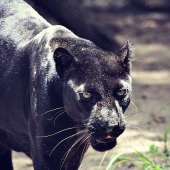LEOPARDS
Class: Mammalia Order: Carnivora Family: Felidae Species: Panthera pardus Status: Near Threatened, Threatened or Endangered (depends on locale and which organization’s classification you use)

There are nine recognized subspecies of leopards including African, Indian, Javan, Arabian, Amur, North Chinese, Caucasian (also called Persian), Indochinese and Sri Lankan. Two more subspecies may exist based on analysis of the skulls. Note that spotted and black leopards are NOT distinct species or subspecies. Catty Shack’s current resident leopards are 3 black leopards.
LIFE SPAN
Leopards may live 12 to 15 years in the wild. 20-25 years in captivity.
DIET
In the wild, leopards survive on a wide variety of kill. They are opportunistic hunters. They can eat hooved animals and monkeys but also rodents, reptiles, amphibians, birds, fish, insects and sometimes smaller predators. Hunting mostly at night, they are known for silently stalking their prey, pouncing and quickly strangling. Their strength and agility allow them to climb a tree, carrying in their mouth much larger animals ( 2 to 3 times their size) to a ‘safe’ hiding place. Leopards coexist with other predators such as lions, tigers, hyenas and wild dogs by hunting for different prey and avoiding areas where others prevail. Catty Shack’s leopards eat 5-7 pounds of food five or six nights a week. The Catty Shack Ranch follows the USDA guidelines and feeds according to their body weight. They also follow strict nutrition requirements from their veterinarians and also add vitamins and minerals to all their food. Their menu is primarily chicken, some fish and red meat. Catty Shack only feeds processed meats, never live.
SIZE
Leopards are the smallest of the four big cats in the ‘Panthera’ genus. Tigers, lions and jaguars are larger. Their head and body length may be 3 to 5.5 feet with their tail adding another 2 to 3.5 feet. Their body is relatively long compared with their leg length and shoulder height. Males are typically about 1/3 larger than females. Due to the variety of habitats and prey, their range of weights is wide. Males may weigh 66 to 200 pounds and females from 50 to 130 pounds.
HABITAT & NUMBERS
REPRODUCTION
Females may deliver cubs anytime during the year after a gestation period of 90 to 105 days. The litter is usual 2 to 4 cubs weighing about one pound each. The cubs nurse for 3 months or longer and begin to follow their mother on hunts at 3 months of age. While they may fend for themselves at one year old, they typically remain with their mother for 18 to 24 months. The first year mortality is high – between 40 and 50%.
OTHER FUN LEOPARD FACTS
Leopards are known for their climbing ability. They rest in trees, hide their food in trees and may hide their cubs in trees for safety. They climb down from trees head first.They are powerful swimmers but not as strong as tigers are.
Leopards are agile. They can run over 36 miles per hour, leap 20 feet horizontally and almost 10 feet vertically.
They grunt, roar, meow and make a raspy coughing sound.
Some differences between Spotted Cats – Leopards, Jaguars and Cheetahs:
Cheetahs are longer, thinner and taller than leopards. They coexist with leopards in Africa.
Jaguars are larger than leopards, have a more muscular appearance and live in Central and South America, where there are no leopards.
Leopards’ spots on their body and head are in a circular to square ‘rosette’ shape. The color in the center of the rosette matches the rest of the animal’s body. The spots on the head and legs are solid. Cheetahs have simple solid black spots. Jaguars have rosette spots with a small spot inside the rosette.

